Hiking Havasupai Falls
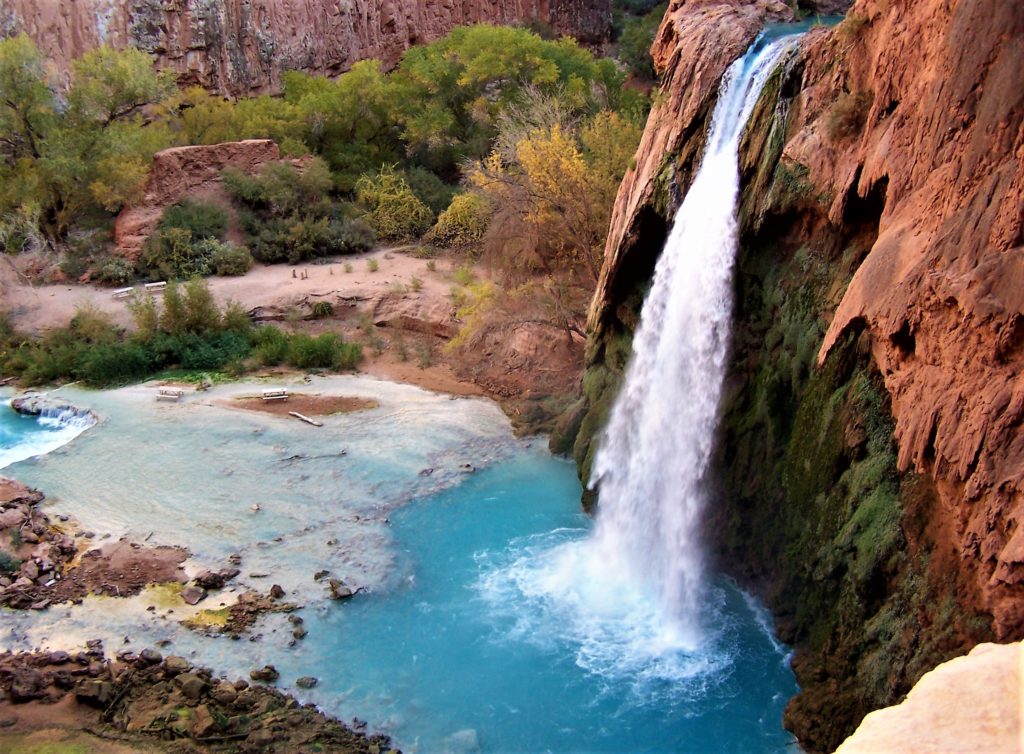
Havasupai Falls finds its way onto many hikers’ bucket lists. Havasupai means “people of the blue green water.” And there’s no shortage of turquoise waterfalls spilling over the red rocks of Arizona’s Havasu Canyon. This may be the most beautiful place I’ve ever been. Here’s how you can enjoy this world-class hiking destination.
Hualapai trailhead
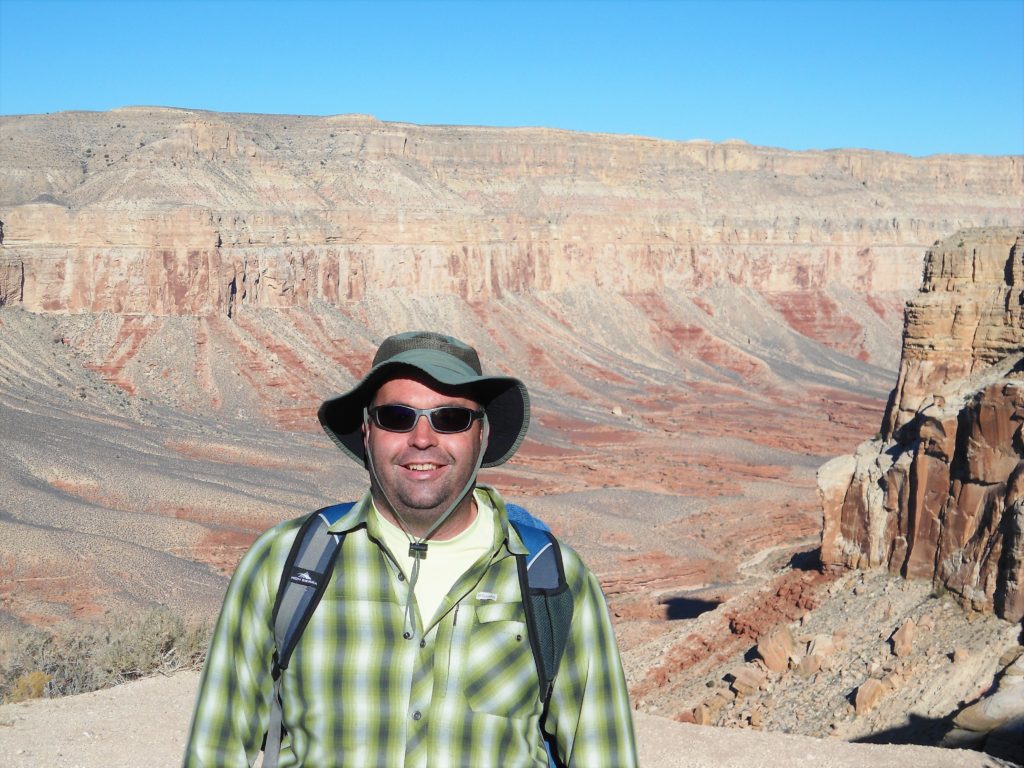
Havasupai Falls is a backpacking trip on the Havasupai Indian Reservation at the edge of the Grand Canyon. Your first challenge is scoring a permit and advance reservations from the Havasupai tribe. (See tips below.) If you’re organized (and lucky) enough to get a permit, you’ll then need to drive hundreds of miles of desolate roads that eventually dead end at a cliff. This is your trailhead: Hualapai Hill.
The Havasupai Falls backpack begins here with an eight-mile (Supai Lodge reservation) or ten-mile (Havasu Falls Campground reservation) hike to Havasu Canyon. (See rough trail map here.) You immediately descend 1200-1500 feet of switchbacks down Haualapi Hill and then trek across several miles of scorched plateau and desert washes. After six-plus miles, you’ll start to see green as you approach the Havasu River basin. Go left at the T and follow the river downstream towards the Indian village of Supai.
Hikers with lodge reservations will be based in Supai. (Check in at the Tourist Office.) Backpackers with camping reservations must hike two more miles to the Havusu Falls Campground. New for 2019, all reservations will be for 4 days and 3 nights. That allows plenty of time to enjoy Havasu Canyon.
upper falls of Havasu Canyon
Welcome to paradise! You’ve now arrived at a remote canyon carved by a toothpaste-colored creek that flows over waterfall after waterfall on its way to the Colorado River. The waterfalls begin a half-mile past the village:

Your first major waterfall is Upper Navaho Falls (aka 50 Foot Falls). This waterfall is partially concealed–look for a small side trail about 1/2 mile past Supai. It will take you to the base of the falls–a popular swimming hole. Havusu Creek then spills over a series of cascades before tumbling over Lower Navajo Falls:
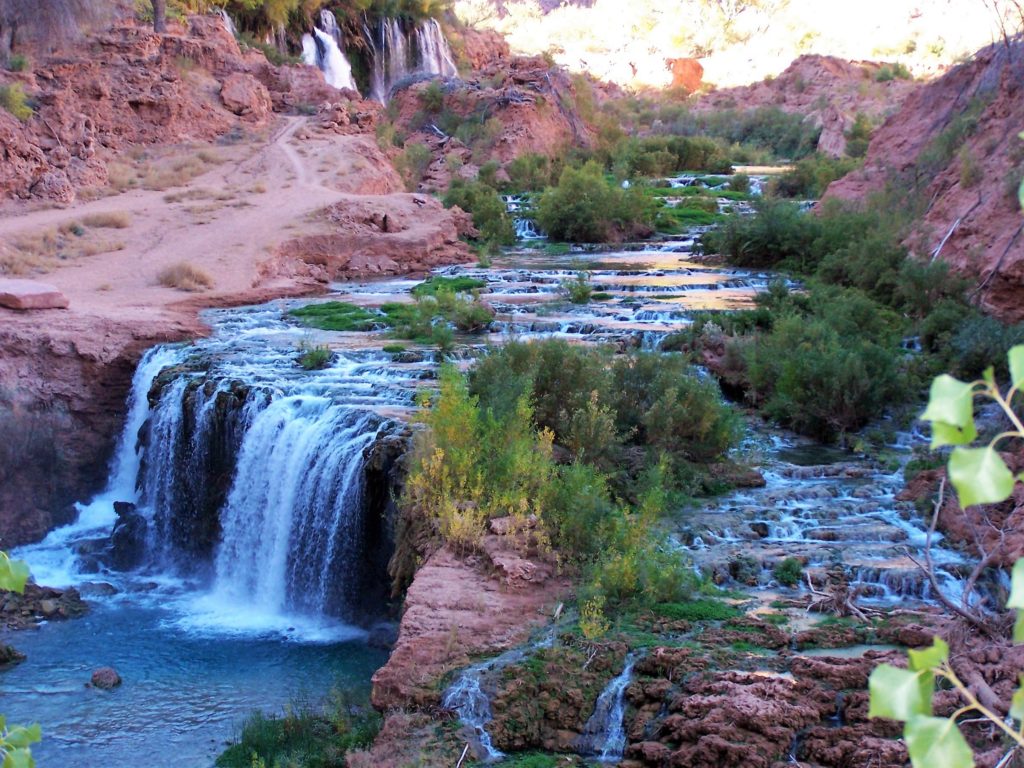
You may already feel as if you’re in a fairy tale or fantasy movie. But you’re just getting started! In about a mile, you’ll reach one of the most photographed waterfalls in the world: Havasu Falls.
Havasu Falls
You’ve probably seen Havasu Falls on magazine covers, Instagram, and other blogs. The photos are not doctored–the water really is that blue. Your first view of the falls is from above. Get out your cameras: you’ve arrived at the money shot (above) that brought you to Havasu Canyon.
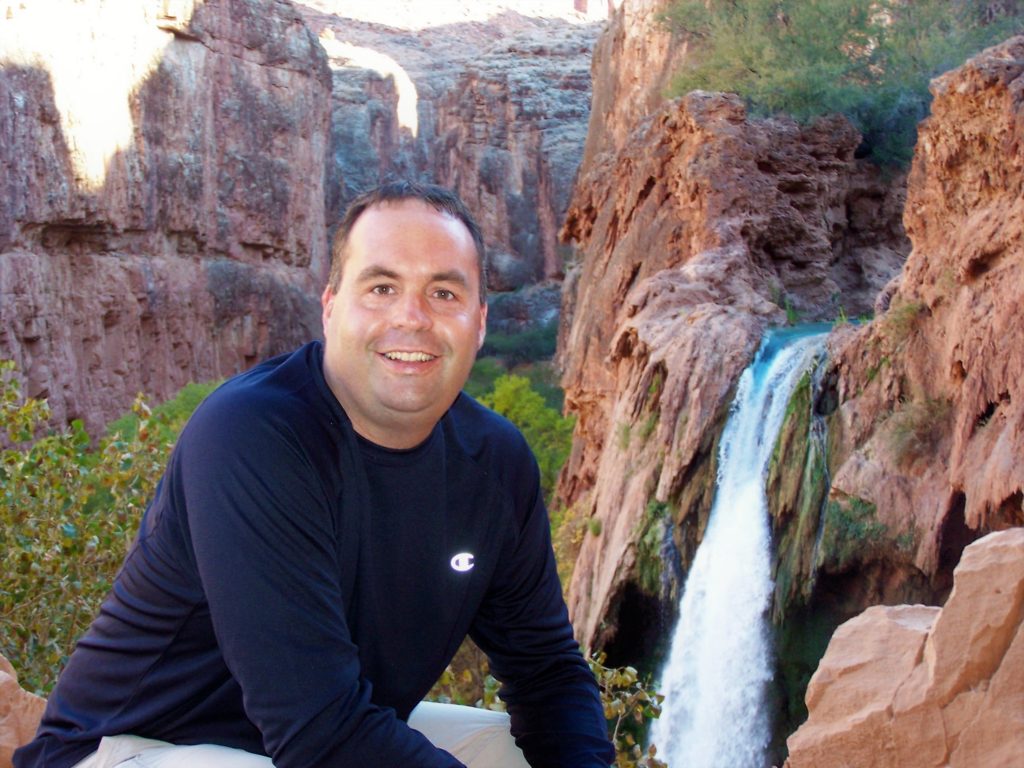
The trail then drops to river level. This is where you’ll want to soak in all the views–or soak in a world-class swimming hole. You won’t be alone here, but this spot is worth savoring.
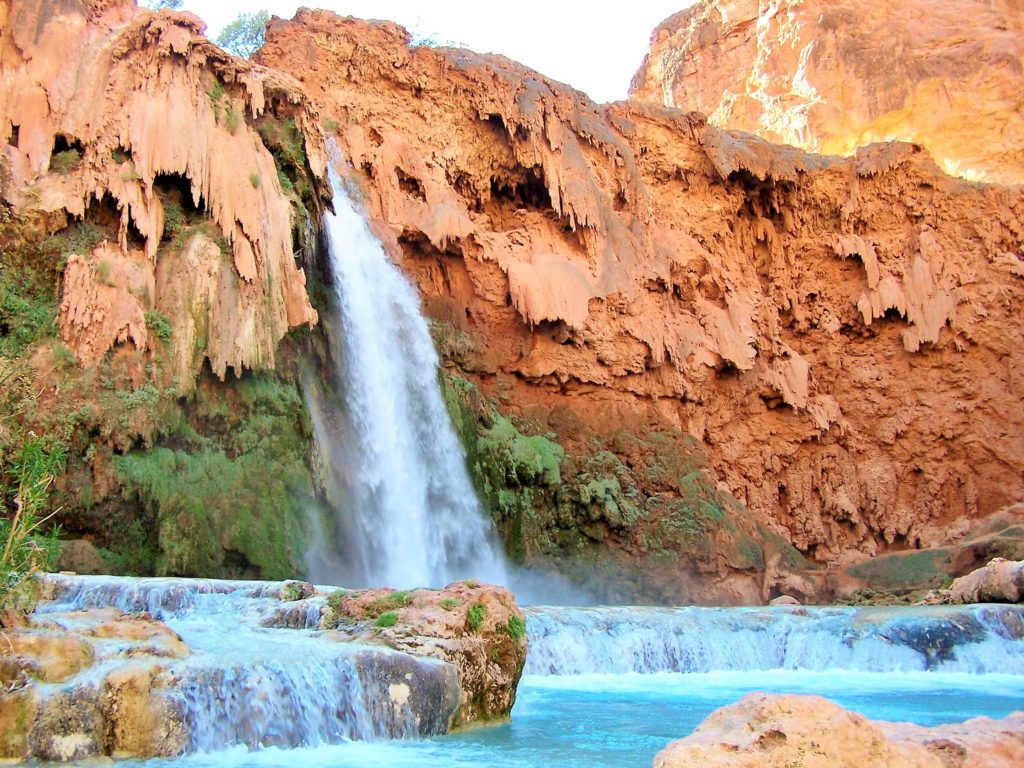
Mooney Falls
Campers will finally reach the campgrounds below Havasu falls. It’s time to drop your packs, pick the best campsite, and refill your water at the natural spring on the edge of the campground. Ideally, you’ll stay two or three nights. This gives you at least one full day in the heart of the canyon to hike and swim–or simply stare at waterfalls and the impossibly blue-green water of Havasu Creek.
The biggest waterfall in Havusu Canyon is Mooney Falls–another mile downstream from the Havasu Falls Campground. Here the river falls 200 feet over a gnarly, red rock cliff. Everyone who visits Havasupai Falls should at least get to the scenic overlook at Mooney Falls:

Descend at your own risk!

To this point, you’ve enjoyed easy to moderate hiking. At the Mooney Falls overlook, however, you’ll see the sign: DESCEND AT OWN RISK! The next leg of the hike is dangerous. To get to the base of Mooney Falls, you must duck into a short cave and walk an exposed ledge before negotiating a steep descent with a 200 foot drop. The footing is obvious, and there are safety chains (see picture). But a stumble here could be fatal.
There’s no shame in turning around at the Mooney Falls Overlook. I know several experienced hikers who have stopped here. (On our trip, for example, the Nepali hikers in front of us turned around here.)
But if you can manage the exposure, your reward is wading or swimming at the base of a 200 foot waterfall.
Mooney Falls to Beaver Falls
Many people turn around at Mooney Falls. Others scramble down to the base of Mooney Falls for a swim–and don’t go much further. But the next few miles of trail–from Mooney Falls to Beaver Falls–was my favorite section of the Havasupai Falls hike.
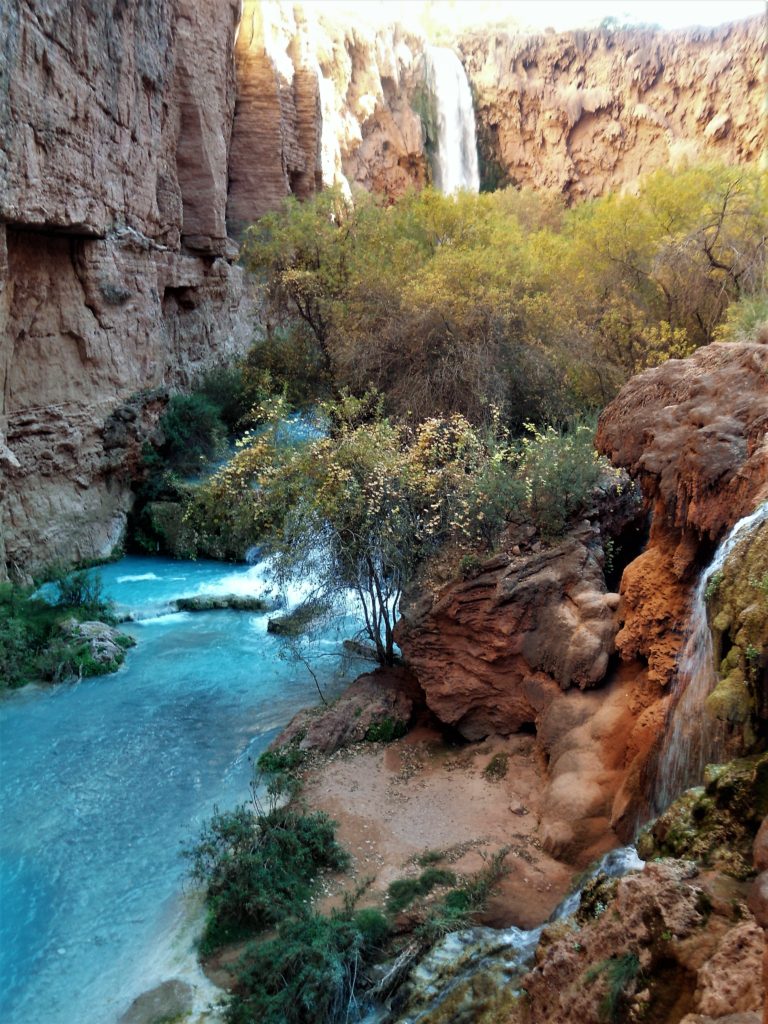
You need to plan ahead to get to Beaver Falls. It’s an 8 mile (from campground) or 12 mile (from lodge) round-trip hike that takes most of the day. To pull this off, you need to leave early in the day to get to Beaver Falls and back.
It’s worth it. The crowds thin out beyond Mooney Falls. And you’ll get up close and personal with Havasu Creek through a series of easy creek crossings.
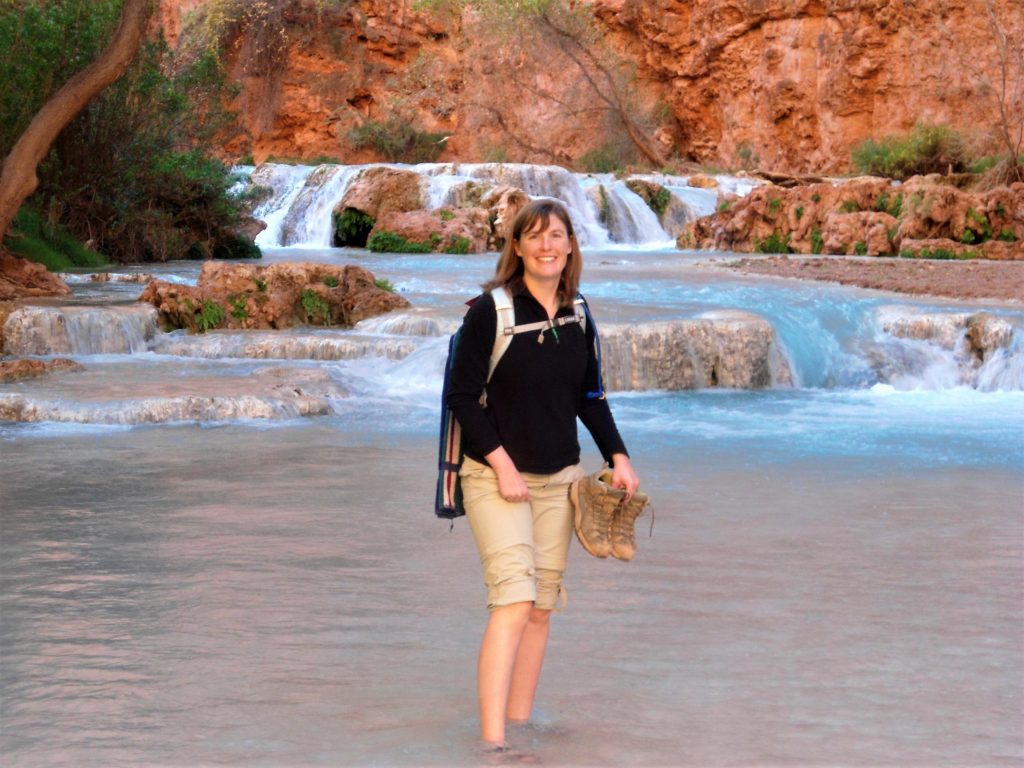
Beaver Falls
Havasu Falls may be the most photographed waterfall in the world. Mooney Falls is even bigger. But my favorite waterfall was Beaver Falls. It’s one cascade after the other. If you’ve got some time, you can find plenty of routes to scramble up Beaver falls, ledge by ledge.
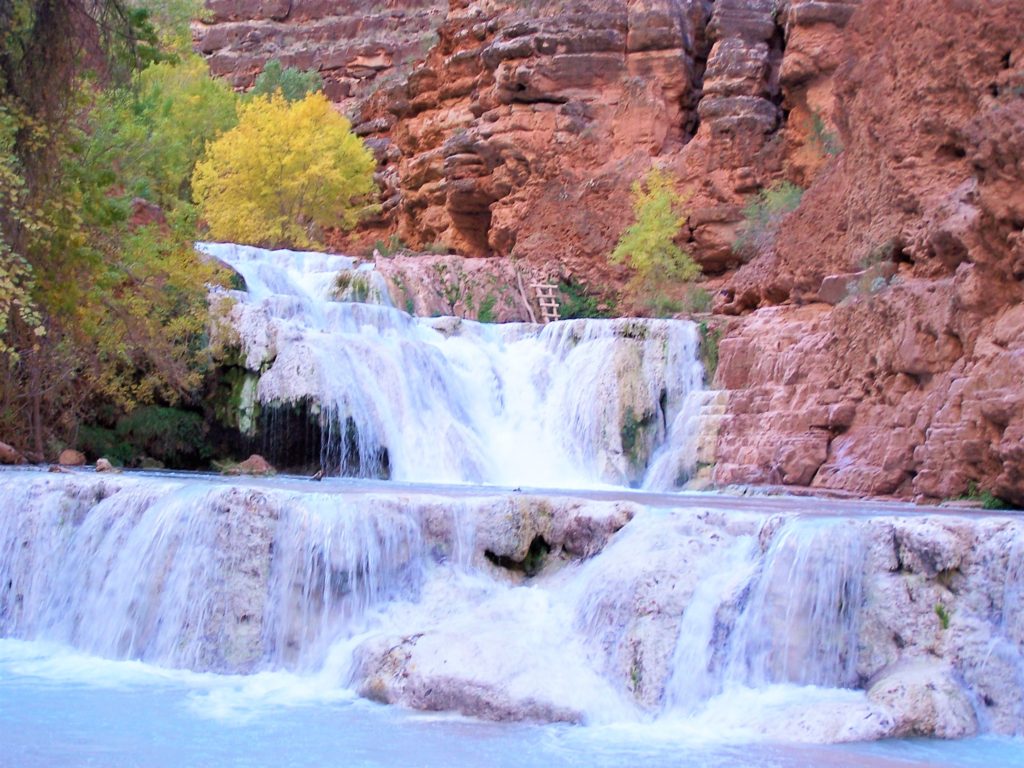
Havasu Canyon to Hualapi Hill
Your hike out of the canyon will be harder than your hike in. It’s best to start early and pack a gallon of water–especially in the summer. Remember, there’s no water and almost no shade. The trail gains 2400 feet of elevation over 8-10 miles as you hike out the same way you hiked in. More than half of the elevation gain accumulates in the last mile–the switch-backs up Hualapi Hill to your vehicle.

Havasupai permits
As noted above, you’ve got to clear two logistical hurdles before you can even attempt this hike. The first challenge is getting your permit.
This is a permit-only hike on the Havasupai Indian Resevation. The tribe requires a permit and advanced reservations to stay at Supai lodge or Havasu Falls Campground.
- Lodge reservations ($175/night): 2019 reservations opened in June, 2018. To book a room in the lodge, you must call +1 (928) 448-2111 or +1 (928) 448-2201. (Don’t be surprised if it takes dozens of calls–or even a hundred calls–to get through. Please be kind.)
- Camping permits. 2019 permits for the campground will be available here on February 1 at 8:00 a.m. You should expect all 2019 permits to sell out within hours of opening on February 1. (The Havasupai tribe recommends setting up an account before February 1 to increase your odds at a permit.) Important changes for 2019 permits: New for 2019, campground permits are only available through the online reservation system. (Phone reservations are no long accepted.) For the first time, the tribe has also mandated reservations of 4 days/3 nights ($100 weekdays/$125 weekends). You must act quickly on the morning of February 1 to have a shot at hiking Havasupai in 2019.
travel tips and directions
It’s also a challenge getting to the trailhead. This is remote country–you’re at least 3.5 hours from Grand Canyon Village (South Rim), 4 hours from Las Vegas, and 4.5 hours from Phoenix. A 4-wheel drive isn’t necessary. But you do need to be cautious about water, food, and gas–especially in summer. Here’s some tips:
- Print directions to the trailhead (“Hualapai Hilltop”). You’ll have limited cell phone access for navigation.
- Avoid driving in the dark on Indian Rd 18. There’s a big risk of hitting livestock or wildlife on the road (even in daylight). And you could easily be stranded for hours with no passing cars and no cell phone reception.
- Your best bet is to spend the night at a roadside motel on historic Route 66, grab an early breakfast, and leave as early as possible for the trail head: You want to reach Hualapai Hills early in the day to minimize the heat and sun exposure on the trail.
- Fill up with gas on Route 66 as close to the reservation as possible. Once you get off the highway, it’s a 130 mile round trip without gas stations.
- You also should not leave the highway without filled water bottles/bladders and snacks. The Havasupai recommend each hiker carry in at least one gallon (4 liters) of water on the hike from Hualapai hilltop to Supai village/Havasu Falls Campground (especially in summer). There’s no reliable water at the trailhead, nor is there reliable water before Havusu Creek.
When to do Havasupai Falls
- The most comfortable temperatures are in spring (March to May) and Fall (late September-October). That’s your best bet to miss the most extreme temperatures and flash floods (and still swim).
- Flash floods are likely during Arizona’s summer monsoon season, which generally peaks in July and lasts into August (and sometimes September). Try to avoid this time slot. And if you find yourself in a thunderstorm (or see brown water in Havasu Creek), head to higher ground immediately and be prepared for emergency evacuations.
- Still, most people visit in the heat of summer. The swimming holes can make the canyon manageable. However, the lack of shade and water make the hike to and from the canyon potentially dangerous. Set your alarms for early morning departures, especially from May to September, to limit your heat and sun exposure on the hike to or from Hualapai Hilltop.
hiker safety
Outside of the chained section at Mooney Falls, the footing at Havasupai Falls is fairly safe. The real danger is heat–especially for hikers who aren’t acclimated to the desert. High temperatures regularly top 100 degrees F (38 C) from May through September, and extreme highs of 115+ (46 C) are not uncommon (46 C). You’ll lose plenty of water on less intense days, too, with sun exposure and dry desert air. Here’s how you can manage the risk of this moderately strenuous desert hike:
- Avoid Havasupai in the summer. Focus on spring or fall.
- Take plenty of water and salty snacks. The general rule for Arizona hiking is one liter of water per hour of hiking–that’s at least a gallon of water for the hike in and out. (More, if its really hot.)
- Leave a cooler of water and snacks in your vehicle for the trip out. You’ll be hot and still have two hours of road time before your first opportunity stop for cold drinks, food, and gas.
- Rattlesnakes are common in the desert, especially when temperatures are in the 80s. Watch where you put your feet and hands, and give snakes plenty of room if you do see them. They’re good at avoiding you. Do your best to avoid them, and you’ll rarely have problems with rattlers.
Supai Village
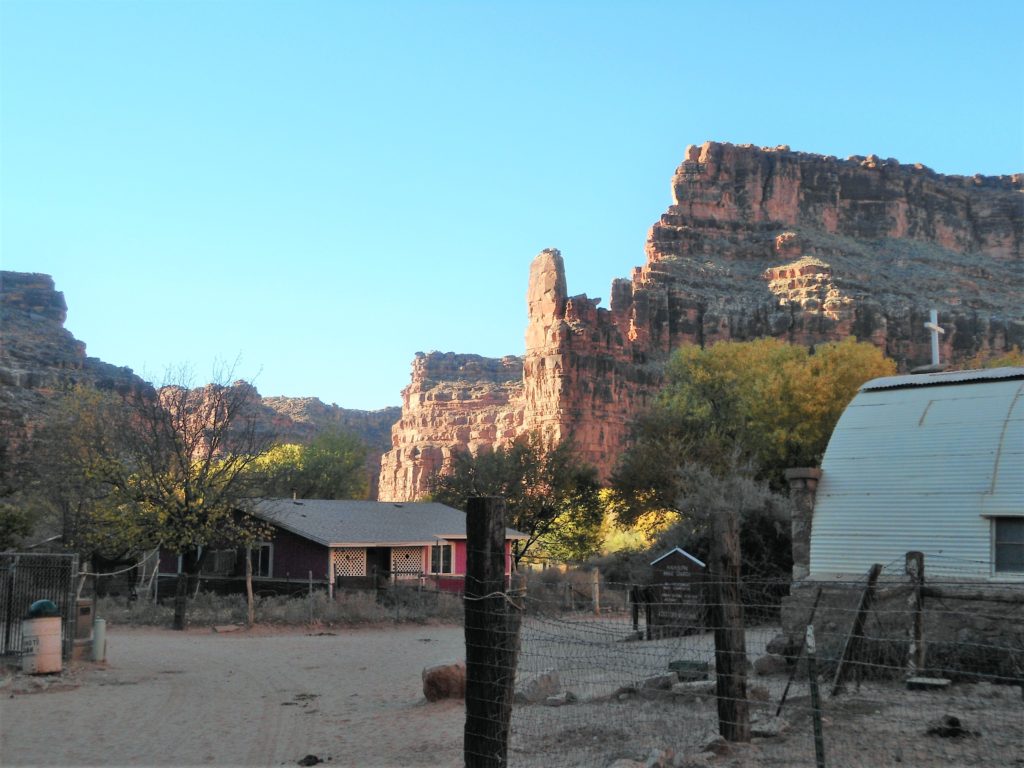
Supai is a remote village on the Havasupai Reservation. You can only get here by foot, by horse (tribe only), or by helicopter. Hikers should register at the tourist office. Those with lodge reservations will check in to the lodge. The store and cafe have limited hours and limited food choices.
The village is home to a few hundred Indians and their horses and dogs. Havasupai have lived here continuously for 1000 years. They are one of the few tribes whose reservation sits on their historical homeland. At the same time, you’ll see considerable poverty and sense how this country’s oppression of indigenous people has negatively affected the tribe.
Too many travelers trash this canyon and violate tribal rules and laws. Leave your alcohol, drugs, drones, and weapons at home. Carry out all of your trash. Camp only in designated areas. Keep your clothes on, and don’t jump or dive off cliffs. It takes a special kind of asshole to trash such a beautiful place and to disrespect an oppressed tribe who’s given access to their desert oasis. Respect the people and the place. Leave your campsite, the water, and the trail cleaner than you found them. Or stay home.
Havasupai Falls is a bucket-lister
The Havasupai Falls backpacking trip is only moderately strenuous, and the logistical challenges of getting there have only increased with its recent surge in popularity. The crowds are taking their toll on Havasu Canyon. But it’s definitely a bucket list hike. It’s remote, and its scenery is world-class–if not other-worldly. If you can get here, this may be the most beautiful place you’ll ever go.